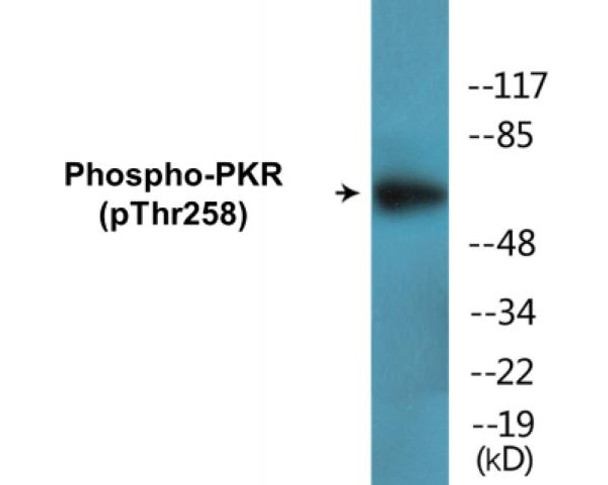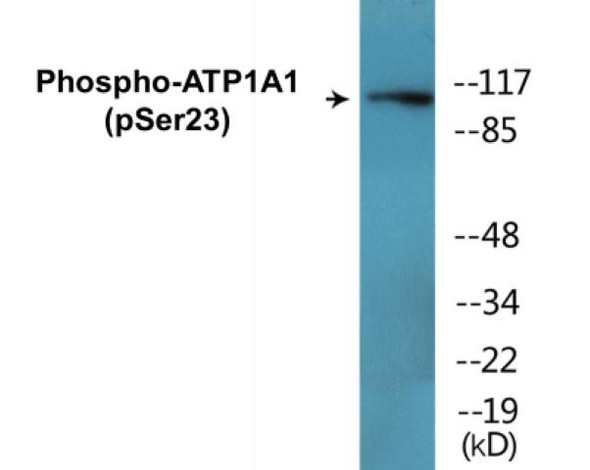PKR (Phospho-Thr258) Colorimetric Cell-Based ELISA Kit
- SKU:
- CBCAB00150
- Product Type:
- ELISA Kit
- ELISA Type:
- Cell Based Phospho Specific
- Research Area:
- Immunology
- Reactivity:
- Human
- Detection Method:
- Colorimetric
Description
PKR (Phospho-Thr258)Colorimetric Cell-Based ELISA Kit
The PKR Phospho-Thr258 Colorimetric Cell-Based ELISA Kit is specifically designed for the accurate detection of phosphorylated PKR (protein kinase R) levels in cell lysates. This kit boasts high sensitivity and specificity, ensuring reliable and reproducible results for your research needs.Phosphorylated PKR plays a critical role in various cellular processes, including the regulation of immune response and the control of viral infection. Dysregulation of PKR phosphorylation has been linked to diseases such as cancer, viral infections, and autoimmune disorders, making it a valuable biomarker for studying these conditions and developing potential therapeutic strategies.
With the PKR Phospho-Thr258 Colorimetric Cell-Based ELISA Kit, researchers can easily quantify phosphorylated PKR levels in cell lysates, providing valuable insights into the role of PKR in cellular signaling pathways and disease progression. Trust in this kit for accurate and precise results in your research endeavors.
| Product Name: | PKR (Phospho-Thr258) Colorimetric Cell-Based ELISA |
| Product Code: | CBCAB00150 |
| ELISA Type: | Cell-Based |
| Target: | PKR (Phospho-Thr258) |
| Reactivity: | Human |
| Dynamic Range: | > 5000 Cells |
| Detection Method: | Colorimetric 450 nm |
| Format: | 2 x 96-Well Microplates |
The PKR (Phospho-Thr258) Colorimetric Cell-Based ELISA Kit is a convenient, lysate-free, high throughput and sensitive assay kit that can detect PKR protein phosphorylation and expression profile in cells. The kit can be used for measuring the relative amounts of phosphorylated PKR in cultured cells as well as screening for the effects that various treatments, inhibitors (ie. siRNA or chemicals), or activators have on PKR phosphorylation.
Qualitative determination of PKR (Phospho-Thr258) concentration is achieved by an indirect ELISA format. In essence, PKR (Phospho-Thr258) is captured by PKR (Phospho-Thr258)-specific primary antibodies while the HRP-conjugated secondary antibodies bind the Fc region of the primary antibody. Through this binding, the HRP enzyme conjugated to the secondary antibody can catalyze a colorimetric reaction upon substrate addition. Due to the qualitative nature of the Cell-Based ELISA, multiple normalization methods are needed:
| 1. | A monoclonal antibody specific for human GAPDH is included to serve as an internal positive control in normalizing the target absorbance values. |
| 2. | Following the colorimetric measurement of HRP activity via substrate addition, the Crystal Violet whole-cell staining method may be used to determine cell density. After staining, the results can be analysed by normalizing the absorbance values to cell amounts, by which the plating difference can be adjusted. |
| Database Information: | Gene ID: 5610, UniProt ID: P19525, OMIM: 176871, Unigene: Hs.131431 |
| Gene Symbol: | E2AK2 |
| Sub Type: | Phospho |
| UniProt Protein Function: | PKR: a protein kinase of the PEK family. Upon binding double-stranded RNA, it becomes autophosphorylated and activated. Phosphorylates and inhibits the alpha subunit of eIF2 alpha, which leads to an inhibition of the initiation of protein synthesis. Controls the activation of several transcription factors such as NF-kappaB, p53 and Stats. Mediates apoptosis induced by many different stimuli, such as LPS, TNF-alpha, viral infection and serum starvation. |
| UniProt Protein Details: | Protein type:Translation; Kinase, protein; EC 2.7.10.2; Protein kinase, Other; Protein kinase, Ser/Thr (non-receptor); EC 2.7.11.1; Other group; PEK family Chromosomal Location of Human Ortholog: 2p22-p21 Cellular Component: membrane; perinuclear region of cytoplasm; cytoplasm; ribosome; nucleus; cytosol Molecular Function:protein serine/threonine kinase activity; protein binding; double-stranded RNA binding; non-membrane spanning protein tyrosine kinase activity; protein phosphatase type 2A regulator activity; ATP binding; eukaryotic translation initiation factor 2alpha kinase activity; protein kinase activity Biological Process: positive regulation of cytokine production; peptidyl-tyrosine phosphorylation; translation; activation of MAPKK activity; transcription, DNA-dependent; unfolded protein response; response to virus; protein amino acid autophosphorylation; viral infectious cycle; protein amino acid phosphorylation; positive regulation of stress-activated MAPK cascade; positive regulation of chemokine production; evasion by virus of host immune response; activation of NF-kappaB transcription factor; negative regulation of cell proliferation; modification by virus of host cellular process; negative regulation of viral genome replication; virus-host interaction; negative regulation of translation; innate immune response; negative regulation of osteoblast proliferation; defense response to virus; negative regulation of apoptosis |
| NCBI Summary: | The protein encoded by this gene is a serine/threonine protein kinase that is activated by autophosphorylation after binding to dsRNA. The activated form of the encoded protein can phosphorylate translation initiation factor EIF2S1, which in turn inhibits protein synthesis. This protein is also activated by manganese ions and heparin. Three transcript variants encoding two different isoforms have been found for this gene. [provided by RefSeq, Oct 2011] |
| UniProt Code: | P19525 |
| NCBI GenInfo Identifier: | 125527 |
| NCBI Gene ID: | 5610 |
| NCBI Accession: | P19525.2 |
| UniProt Secondary Accession: | P19525,Q52M43, Q7Z6F6, Q9UIR4, A8K3P0, D6W584, E9PC80 |
| UniProt Related Accession: | P19525 |
| Molecular Weight: | 62,094 Da |
| NCBI Full Name: | Interferon-induced, double-stranded RNA-activated protein kinase |
| NCBI Synonym Full Names: | eukaryotic translation initiation factor 2-alpha kinase 2 |
| NCBI Official Symbol: | EIF2AK2 |
| NCBI Official Synonym Symbols: | PKR; PRKR; EIF2AK1; PPP1R83 |
| NCBI Protein Information: | interferon-induced, double-stranded RNA-activated protein kinase; p68 kinase; eIF-2A protein kinase 2; P1/eIF-2A protein kinase; tyrosine-protein kinase EIF2AK2; interferon-inducible elF2alpha kinase; double stranded RNA activated protein kinase; protein phosphatase 1, regulatory subunit 83; protein kinase, interferon-inducible double stranded RNA dependent |
| UniProt Protein Name: | Interferon-induced, double-stranded RNA-activated protein kinase |
| UniProt Synonym Protein Names: | Eukaryotic translation initiation factor 2-alpha kinase 2; eIF-2A protein kinase 2; Interferon-inducible RNA-dependent protein kinase; P1/eIF-2A protein kinase; Protein kinase RNA-activated; PKR; Tyrosine-protein kinase EIF2AK2 (EC:2.7.10.2); p68 kinase |
| UniProt Gene Name: | EIF2AK2 |
| UniProt Entry Name: | E2AK2_HUMAN |
| Component | Quantity |
| 96-Well Cell Culture Clear-Bottom Microplate | 2 plates |
| 10X TBS | 24 mL |
| Quenching Buffer | 24 mL |
| Blocking Buffer | 50 mL |
| 15X Wash Buffer | 50 mL |
| Primary Antibody Diluent | 12 mL |
| 100x Anti-Phospho Target Antibody | 60 µL |
| 100x Anti-Target Antibody | 60 µL |
| Anti-GAPDH Antibody | 60 µL |
| HRP-Conjugated Anti-Rabbit IgG Antibody | 12 mL |
| HRP-Conjugated Anti-Mouse IgG Antibody | 12 mL |
| SDS Solution | 12 mL |
| Stop Solution | 24 mL |
| Ready-to-Use Substrate | 12 mL |
| Crystal Violet Solution | 12 mL |
| Adhesive Plate Seals | 2 seals |
The following materials and/or equipment are NOT provided in this kit but are necessary to successfully conduct the experiment:
- Microplate reader able to measure absorbance at 450 nm and/or 595 nm for Crystal Violet Cell Staining (Optional)
- Micropipettes with capability of measuring volumes ranging from 1 µL to 1 ml
- 37% formaldehyde (Sigma Cat# F-8775) or formaldehyde from other sources
- Squirt bottle, manifold dispenser, multichannel pipette reservoir or automated microplate washer
- Graph paper or computer software capable of generating or displaying logarithmic functions
- Absorbent papers or vacuum aspirator
- Test tubes or microfuge tubes capable of storing ≥1 ml
- Poly-L-Lysine (Sigma Cat# P4832 for suspension cells)
- Orbital shaker (optional)
- Deionized or sterile water
*Note: Protocols are specific to each batch/lot. For the correct instructions please follow the protocol included in your kit.
| Step | Procedure |
| 1. | Seed 200 µL of 20,000 adherent cells in culture medium in each well of a 96-well plate. The plates included in the kit are sterile and treated for cell culture. For suspension cells and loosely attached cells, coat the plates with 100 µL of 10 µg/ml Poly-L-Lysine (not included) to each well of a 96-well plate for 30 minutes at 37°C prior to adding cells. |
| 2. | Incubate the cells for overnight at 37°C, 5% CO2. |
| 3. | Treat the cells as desired. |
| 4. | Remove the cell culture medium and rinse with 200 µL of 1x TBS, twice. |
| 5. | Fix the cells by incubating with 100 µL of Fixing Solution for 20 minutes at room temperature. The 4% formaldehyde is used for adherent cells and 8% formaldehyde is used for suspension cells and loosely attached cells. |
| 6. | Remove the Fixing Solution and wash the plate 3 times with 200 µL 1x Wash Buffer for five minutes each time with gentle shaking on the orbital shaker. The plate can be stored at 4°C for a week. |
| 7. | Add 100 µL of Quenching Buffer and incubate for 20 minutes at room temperature. |
| 8. | Wash the plate 3 times with 1x Wash Buffer for 5 minutes each time. |
| 9. | Add 200 µL of Blocking Buffer and incubate for 1 hour at room temperature. |
| 10. | Wash 3 times with 200 µL of 1x Wash Buffer for 5 minutes each time. |
| 11. | Add 50 µL of 1x primary antibodies Anti-PKR (Phospho-Thr258) Antibody, Anti-PKR Antibody and/or Anti-GAPDH Antibody) to the corresponding wells, cover with Parafilm and incubate for 16 hours (overnight) at 4°C. If the target expression is known to be high, incubate for 2 hours at room temperature. |
| 12. | Wash 3 times with 200 µL of 1x Wash Buffer for 5 minutes each time. |
| 13. | Add 50 µL of 1x secondary antibodies (HRP-Conjugated AntiRabbit IgG Antibody or HRP-Conjugated Anti-Mouse IgG Antibody) to corresponding wells and incubate for 1.5 hours at room temperature. |
| 14. | Wash 3 times with 200 µL of 1x Wash Buffer for 5 minutes each time. |
| 15. | Add 50 µL of Ready-to-Use Substrate to each well and incubate for 30 minutes at room temperature in the dark. |
| 16. | Add 50 µL of Stop Solution to each well and read OD at 450 nm immediately using the microplate reader. |
(Additional Crystal Violet staining may be performed if desired – details of this may be found in the kit technical manual.)










